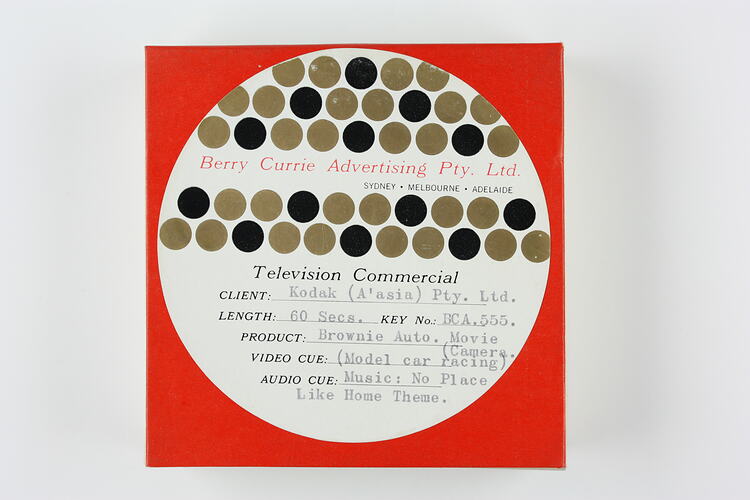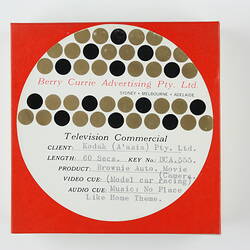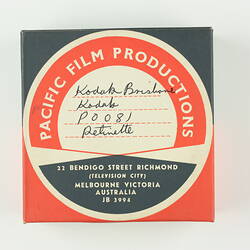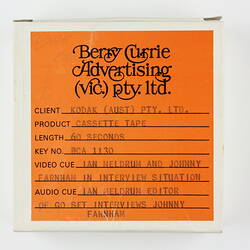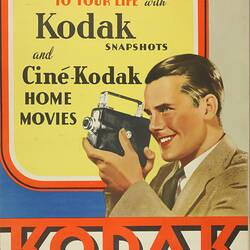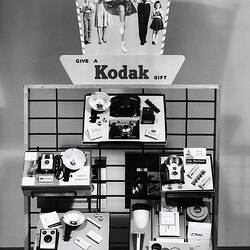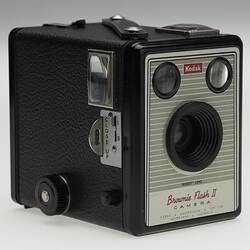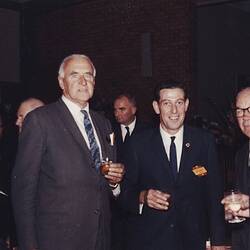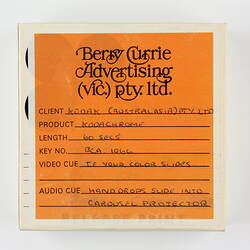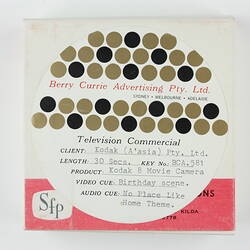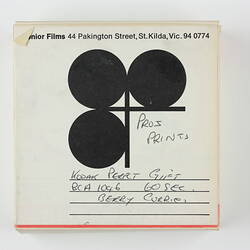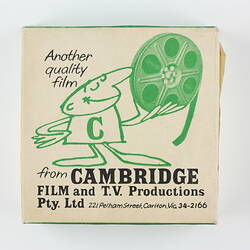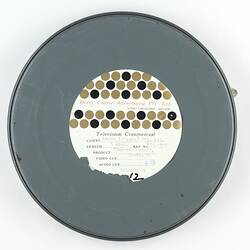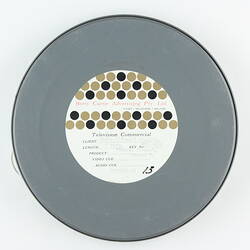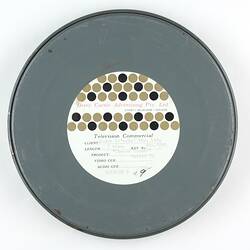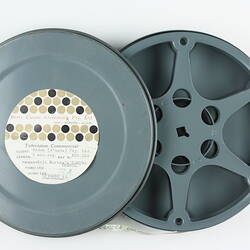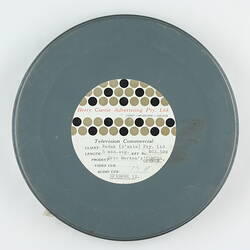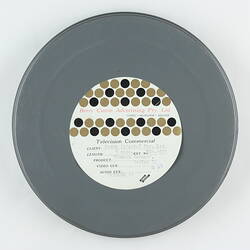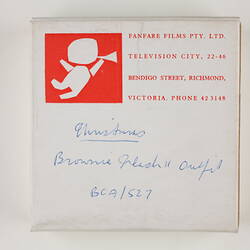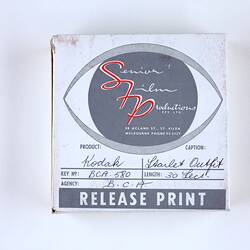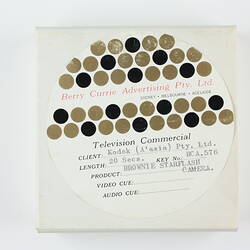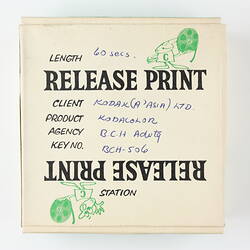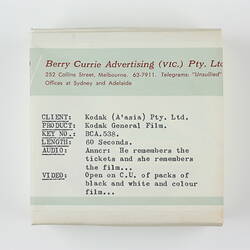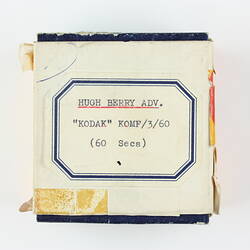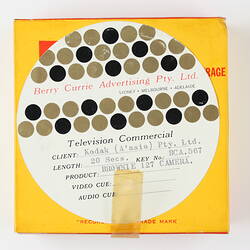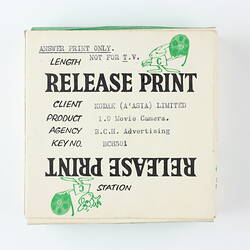Summary
"Brought to you by Kodak"
Kodak Australasia spent a large amount of their marketing budget in the mid-twentieth century on television advertising. The company kept a collection of these lively, 30 to 60-second television commercials, which were aired from the late 1950s to mid-1970s. These 16mm film reels, in colour and black and white, were packaged and labelled by the advertising and film production companies that produced the commercials.
Most of Kodak's television commercials were produced by Berry Currie Advertising - a Melbourne-based advertising agency. Berry Currie worked with a wide variety of Melbourne and Sydney based film production companies, including Fanfare Films, Senior Film Productions, Browning Studios, Cambridge Film and TV Productions, Aranda Film Productions, and Bilcock and Copping. Many of these were private companies run from television stations, for example Channel 9's Television City in Richmond. From the late 1960s to early 1970s there was a surge in these local film production companies in response to the growth of the television industry, and many of these companies are represented here in Kodak's collection.
All Kodak television commercials were aimed at the amateur - the photographer who wanted something easy to record their lives with. For this reason, the advertisements primarily featured families, and a great deal of the commercials were filmed in domestic or holiday settings. They were screened during summer when people were planning to go on holidays and buy Christmas gifts. The early commercials in particular, those recorded in the late 1950s, early 1960s, show viewers how to use their camera or film, sometimes literally explaining how to load it. Early Kodacolor commercials pointed out that colour film could be used with any camera. Colour film for still photography was just being introduced at affordable prices to the consumer market in the early 1960s, so while television itself was still in black and white, motion picture ads allowed consumers to see how they might use colour to more accurately record their lives.
The commercials use nostalgia and leisure to sell the idea of taking pictures. They encourage memory-making and photography as a "fun", easy activity. This idea of "fun" is no more plainly stated than in the 1962 commercial for Kodak colour film, 'Fun's More Fun'. The jingle's chorus states:
"Fun's more fun, life's more fun
when a camera helps you recall.
Fun's more fun, twice the fun
when a fun saver saves it all."
The photographer is no longer a photographer, but a 'fun saver'. The implied but unstated message underpinning most of these advertisements, especially in the early 1960s, is 'Buy Kodak, or forget'.
In the late 1960s to early 1970s, advertising in Australia began to change. Agencies like Berry Currie were influenced by the 'creative revolution' in America, which signalled a dramatic shift away from traditional advertising forms based on market research to a new, instinctive, 'creative' approach focused on trustworthiness and, in Australia, a growing sense of nationalism. Australian audiences were cynical about the advertising industry and its intentions, so successful campaigns tried to counterbalance this cynicism by presenting companies as trustworthy and 'down to earth'. In Australia, commercials began using the real Australian accent for the first time, and 'ockerism' became a regular feature of television advertising for a period (Crawford, R. 2008). Campaigns used humour to show that companies didn't take themselves too seriously - they could be trusted.
Kodak Australasia's campaigns at this time reflected these changes but refrained from going so far as to openly make fun of their own product. Ads like 'Grab the Handle', 'Too Easy for Words', and the Kodak 'Save-A-Stack Pack' feature young people pulling pranks and joking with each other and the audience. All of the commercials feature strong Australian accents.
Generally, Kodak Australasia's television commercials were typical of their period in advertising history. They did not overtly challenge audiences or break new ground, although they did reflect changing creative trends in the industry in the 1960s and 1970s. It is difficult to gauge how successful Kodak's campaigns were, as there is little market research or sales data from this period. Kodak commercials used the tried and tested formulas of their time, with simple and effective messages aimed to convince audiences to take photographs and use Kodak film.
References
Entertainment Media, n.d., Entertainment Media History and Background, Melbourne, viewed 21 January 2014, http://www.questco.com.au/entertainmentmedia/EMProjects/History.htm
Moran, J. 2002, There's No Place Like Home Video, University of Minnesota Press, Minnesota, USA.
O'Brien, J. 2009. 'In the Van of Film Resurgence', The Age National, 12 August, viewed 21 January 2014, http://www.theage.com.au/national/in-the-van-of-film-resurgence-20090811-egzp.html
Richards, M. & Clark, E. 2011, 'VALE Mike Browning 25/10/33 - 06/08/2011', Australian Cinematographers Society, viewed 21 January 2014, http://www.cinematographer.org.au/cms/page.asp?ID=20226
Crawford, R. 2008, But Wait, There's More.. .- A History of Australia's Advertising Industry, 1900-2000, 1, Melbourne University Press, Melbourne, Australia.
Hutchings, A. 1996. 'The battle for consumer power: Post-war women and advertising', Journal of Australian Studies, Volume 20, Issue 50-51, viewed 30 January 2014, http://www.api-network.com/main/index.php?apply=scholars&webpage=default&flexedit=&flex_password=&menu_label=&menuID=homely&menubox=&scholar=233
West, N.M. 2000, Kodak and the Lens of Nostalgia, University of Virginia Press, USA
More Information
-
Keywords
Photography, Advertising, Retailing, Promotional Materials, Television Production
-
Authors
-
Article types
